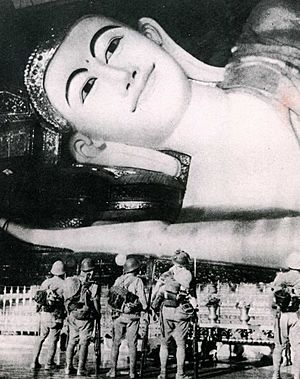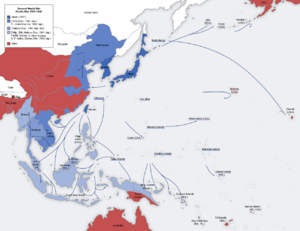Burma campaign (1942–1943) facts for kids
Quick facts for kids Burma campaign 1942–1943 |
|||||||
|---|---|---|---|---|---|---|---|
| Part of the Pacific War during World War II | |||||||
 Japanese troops at the Shwethalyaung Buddha in Pegu |
|||||||
|
|||||||
| Belligerents | |||||||
|
|
|
||||||
| Commanders and leaders | |||||||
|
|
||||||
| Casualties and losses | |||||||
The Burma campaign was a series of battles fought in Burma during World War II. It was part of the larger Pacific War in the South-East Asian Theatre. This period covers the first year of the campaign, from June 1942 to September 1943.
In early 1942, the Imperial Japanese Army, helped by local Burmese fighters, pushed British and Chinese forces out of most of Burma. From May to December 1942, there wasn't much fighting. This was because of the heavy monsoon rains, which made it almost impossible to move troops and supplies through the thick forests and mountains between India and Burma. Both the Allies and the Japanese also faced big problems getting enough supplies.
When the rains stopped, the Allies launched two attacks. One attack in the coastal Arakan Province failed, which really hurt the Allies' spirits. However, their morale improved thanks to better training and organization. It also got a boost from a famous raid by troops led by Brigadier Orde Wingate. This raid might have even made the Japanese decide to launch their own big attacks the next year, which ended very badly for them.
Contents
India and Burma: Mid-1942
Around 450,000 Allied soldiers faced about 300,000 Japanese soldiers. But both sides struggled with the tough land and getting supplies. The border between Burma and India was mostly wild country, with very few paths through the jungle-covered hills.
The Japanese could use trains and rivers to move supplies only up to Kalewa on the Chindwin River. The Allies relied on poor train and river links to Dimapur in the Brahmaputra River valley. From there, only one road led to their main base at Imphal.
Allies' Challenges
Britain's military leaders saw the Far East as their lowest priority. They focused most of their efforts on the Middle East. This was partly because the United States, led by President Franklin Roosevelt, had a "Germany First" plan. This meant few resources went to India. Even new units of the British Indian Army were trained for desert fighting, not jungle warfare, until late 1942.
Allied efforts in India were also made harder by problems in Eastern India. There were protests and a terrible famine that caused many deaths. These issues meant that many British troops were needed to keep order and help with the crisis, instead of fighting the Japanese.
Axis' Plans
The Japanese were making their hold on Burma stronger. Lieutenant General Shojiro Iida, who led the Japanese Fifteenth Army, was asked if they should attack again after the rains. He asked his division commanders, who said the land was too hard and they couldn't get enough supplies. So, plans for an attack were put on hold.
In Burma, the Japanese changed the Burma Independence Army. They replaced it with the Burma Defence Army, which was trained by Japanese officers. They also started to set up a Burmese government, called the State of Burma, in May 1943, led by Ba Maw. This government didn't have much real power, as the Japanese still controlled most things. Burma's economy suffered because of the earlier fighting and damaged transport routes.
Lieutenant General Iida tried to help Burma, but his ideas were often ignored by orders from Tokyo. He was replaced in 1943, partly because he disagreed with Tokyo's economic plans for Burma.
Key Operations
First Arakan Campaign
The Allies tried two main operations during the dry season of 1942–1943. The first was a small attack in the coastal Arakan area of Burma. The Indian Eastern Army, led by Lieutenant General Noel Irwin, wanted to take back the Mayu peninsula and Akyab Island, which had an important airfield.
Starting on December 21, 1942, the 14th Indian Division moved forward to Rathedaung and Donbaik. They were stopped by a small Japanese force that had very strong bunkers. Indian and British troops attacked many times without tank support and were pushed back with heavy losses.
Japanese reinforcements arrived from Central Burma. They crossed rivers and mountains that the Allies thought were impossible to cross. On April 3, 1943, they attacked the 14th Division's left side and took over several units. The division had to retreat almost back to the Indian border, leaving much equipment behind.
General Irwin was removed from his command after this failure. His replacement, General George Giffard, focused on improving the army's organization and morale.
First Chindit Expedition
The second operation was more unusual. Brigadier Orde Wingate led the 77th Indian Infantry Brigade, also known as the Chindits. These soldiers went deep behind Japanese lines into Burma. Their first goal was to cut the main north-south railway in Burma. This operation, called "Longcloth," was supposed to be part of a much bigger attack. But that larger attack was cancelled because there weren't enough supplies. Wingate decided to go ahead with his part anyway.
About 3,000 men went into Burma in seven groups. They did some damage to Japanese communication lines in northern Burma, cutting the railway for about two weeks. However, they suffered many losses: 818 men were killed, wounded, or went missing. Many who returned were sick and in very bad physical shape.
Even though some questioned if the raid was worth it, it was used to show British and Indian soldiers that they could fight and survive in the jungle just like the Japanese. This helped to change the idea that the Japanese were unbeatable in such tough terrain.
Japanese commanders later said that this Chindit operation made them decide to attack India in 1944, instead of just defending their positions.
Central Front Skirmishes
There was constant patrolling and small fights on the border south of Imphal. But neither army had enough resources for big attacks. The 17th (Light) Indian Division held positions around Tiddim, which was at the end of a difficult supply line about 100 miles (160 km) south of Imphal. They had small battles with units of the Japanese 33rd Division. The Japanese had an easier supply line from Kalewa on the Chindwin River, and they had the upper hand for most of 1942 and 1943.
V Force, a special group formed by the Allies in the border areas, also patrolled and gathered information. But they couldn't stop major Japanese operations.
Supplying China: The "Hump"
The Americans really wanted to keep supplies flowing to the Chinese government led by Chiang Kai-shek. When the Japanese took over Burma, the supply route through Rangoon was cut. So, the Americans started flying supplies over the Himalaya mountains. This route and the flights were nicknamed "The Hump". There were many losses due to the dangerous weather and Japanese fighter planes attacking from Myitkyina airfield in northern Burma.
General Joseph Stilwell, an American who worked with Chiang Kai-shek, insisted that the Allies also start building the Ledo Road. This road would connect India with China and was a huge engineering challenge. To prepare for this road through Japanese-held northern Burma, two Chinese divisions that had retreated into India were re-equipped and trained by Americans. The Americans also formed a special long-range unit, later known as Merrill's Marauders, and sent them to Ledo.
The Americans also sent supply units to improve and maintain Allied railway lines and river transport in Northeast India. This was all in preparation for bigger Allied attacks in 1944.
Fort Hertz Outpost
In mid-1942, a small group of Allied scouts parachuted into the Myitkyina area. They were checking on Myitkyina and a remote outpost called Fort Hertz in far northern Burma, which had been cut off. They found Fort Hertz was still held by the Allies. More soldiers and engineers were flown or parachuted in, and a local fighting group called the Kachin Levies was formed. The airstrip at Fort Hertz was improved to be an emergency landing spot for planes flying "The Hump."
The Kachin Levies later worked closely with the American Northern Combat Area Command to help with the American and Chinese advance from Ledo.
Burma Railway
Like the Allies, the Japanese wanted to improve their supply routes in Southeast Asia. So, they built the Burma Railway, which connected Moulmein in Southern Burma with Bangkok in Siam. Construction started on June 22, 1942, and finished on October 17, 1943. This project became famous for the terrible conditions and the many deaths among the workers. About 90,000 out of 180,000 Asian workers and 16,000 out of 60,000 Allied prisoners of war died.
Aftermath and Changes
Allied Command Changes
The Allies thought their command structure in India was not working well. GHQ India, led by General Archibald Wavell, was in charge of many things. This included operations in Persia and Iraq, fighting the Japanese in Burma, keeping order in India, and managing the growing Indian Army. Many felt GHQ India was too big and inefficient.
In August 1943, a new command was created: the South East Asia Command. This new group took over control of planning and operations against the Japanese in Burma and the Indian Ocean. In November, Admiral Louis Mountbatten was made Commander in Chief of this new command. General Stilwell was made Deputy Supreme Commander because the area was linked to the American China Burma India Theater (CBI), and more American air force units and supplies were coming to India.
Wavell became Viceroy of India. He immediately worked to help with the famine in Bengal. General Claude Auchinleck replaced him as Commander in Chief of the Indian Army. During the Arakan campaign, it was noticed that the morale of the Indian troops was low, and many left their units or even joined the Indian National Army. Auchinleck worked to improve the Indian Army's headquarters and training. They also increased soldiers' pay and gave non-commissioned officers more responsibility to boost morale.
The Eastern Army was also split. The Fourteenth Army became part of South East Asia Command and was responsible for fighting in Manipur and Arakan. The Eastern Command reported to GHQ India and was in charge of security and supply lines behind the front.
Japanese Command Changes and Plans
In March 1943, the Japanese created a new army headquarters called the Japanese Burma Area Army to control operations in Burma. Lieutenant General Masakazu Kawabe was put in charge. This army took command of the Fifteenth Army in the north and east of the country.
In August, Lieutenant General Iida was replaced as commander of the Fifteenth Army by Lieutenant General Renya Mutaguchi. Mutaguchi, who had once doubted an attack, now strongly pushed for a bold attack into India for the next year. This attack plan, called U-Go, was approved and launched the following year.


